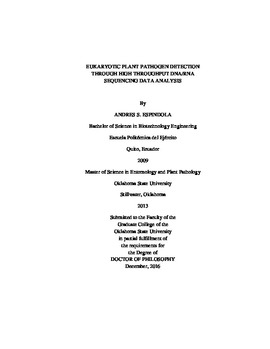| dc.contributor.advisor | Garzon, Carla | |
| dc.contributor.author | Espindola, Andres S. | |
| dc.date.accessioned | 2018-06-25T13:38:20Z | |
| dc.date.available | 2018-06-25T13:38:20Z | |
| dc.date.issued | 2016-12 | |
| dc.identifier.uri | https://hdl.handle.net/11244/300237 | |
| dc.description.abstract | Plant pathogen detection is crucial for developing appropriate management techniques. A variety of tools are available for rapid plant pathogen detection. Most tools rely on unique features of the pathogen to detect its presence. Immunoassays rely on unique proteins while genetic approaches rely on unique DNA signatures. However, most of these tools can detect a limited number of pathogens at once. E-probe Diagnostics Nucleic acid Analysis (EDNA) is a bioinformatic tool originally designed as a theoretical approach to detect multiple plant pathogens at once. EDNA uses metagenomic databases and bioinformatics to infer the presence/absence of plant pathogens in a given sample. Additionally, EDNA relies on a continuous design and curation of unique signatures termed e-probes. EDNA has been successfully validated in viral, bacterial and eukaryotic plant pathogens. However, most of these validations have been performed solely at the species level and only using DNA sequencing. My thesis involved the refinement of EDNA to increase its detection scope to include plant pathogens at the strain/isolate level. Additional refinements included its increasing EDNA's capacity to use transcriptomic analysis to detect actively infecting plant pathogens and metabolic pathways. Actively infecting/growing plant pathogen detection was performed by using Slerotinia minor as an eukaryotic model system. We sequenced and annotated the genome of S. minor to be able to use its genome for e-probe generation. In vitro detection of actively growing S. minor was successfully achieved using EDNA for RNA sequencing analysis. However, actively infecting S. minor in peanut was non-detectable. EDNA's capacity to detect the aflatoxin metabolic pathway was also assessed. Actively producing aflatoxin A. flavus strains (AF70) were successfully used to differentially detect the production of aflatoxin when A. flavus grows in an environment conducive for the production of aflatoxin (maize). Finally, EDNA's detection scope was assessed with eukaryotic strains having very low genetic diversity within its species (Pythium aphanidermatum). We were able to successfully discriminate P. aphanidermatum P16 strain from P. aphanidermatum BR444, concomitantly, these two strains were differentiated from other related species (Globisporangium irregular and Pythium deliense) in the same detection run trial. | |
| dc.format | application/pdf | |
| dc.language | en_US | |
| dc.rights | Copyright is held by the author who has granted the Oklahoma State University Library the non-exclusive right to share this material in its institutional repository. Contact Digital Library Services at lib-dls@okstate.edu or 405-744-9161 for the permission policy on the use, reproduction or distribution of this material. | |
| dc.title | Eukaryotic plant pathogen detection through high throughput DNA/RNA sequencing data analysis | |
| dc.contributor.committeeMember | Schneider, William | |
| dc.contributor.committeeMember | Marek, Stephen | |
| dc.contributor.committeeMember | Melouk, Hassan | |
| osu.filename | Espindola_okstate_0664D_14914.pdf | |
| osu.accesstype | Open Access | |
| dc.type.genre | Dissertation | |
| dc.type.material | Text | |
| thesis.degree.discipline | Plant Pathology | |
| thesis.degree.grantor | Oklahoma State University | |
